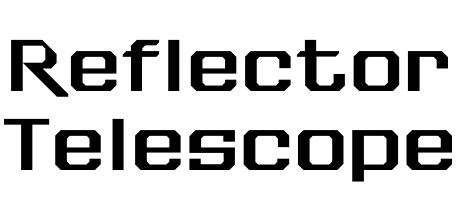
After Galileo had made the telescope popular, the space seemed to be closer to the earth. The space enthusiasts could see the moon, planets and various other objects which was impossible for the naked eyes, but then they figured out a problem that hindered the clarity of the image. The images happened to have missed some of its clarity because of a colour smear that formed around it. It is known as the chromatic aberration and is due to the different wavelengths of the colour spectrum and different focal points after getting refracted from the lens. In that course of time, while various scientists were trying to resolve the issue, Isaac Newton came with his new concept and built a new type of telescope in the year 1668. It not only made the colour smears disappear but also made various improvements, which the Galilean (refractor) telescope was missing on. It was the Reflector Telescope, also known as the Newtonian Telescope.
A Reflector Telescope is the new-age telescope which uses mirror instead of lens as the objective glass or the primary glass which will collect light from the object. The mirror is placed at the bottom of the tube of the telescope and has a flat glass end while the front part is a concave coated with a thin metal film, such as aluminium. There is also a mirror placed at the centre aligned with the help of a thin wire so that it can reflect the focused light reflected from the primary mirror to the eyepiece, the lens, which is kept on the top of the tube. It is through the eyepiece that one can view a magnified and clear image of the far-off object. Today, it has become the most popular telescope overcoming all the disadvantages of the refractor telescope.
Firstly, it works on the principle of reflection from mirror which helps in collecting more light than a lens because unlike lens, light does not pass through mirror. So, maximum light from the object is reflected to form a better image. Since the light does not pass through a different medium, the light is reflected back as it is and gets focused on one point where the image is formed. The concave mirror placed at the bottom of the tube formed the image in its front. In order to view the image, a small flat mirror is hanged in the centre, at 45°, which will hardly affect the amount of light that will hit on the mirror. The small mirror reflects the focussing light before it could meet at the focal point to form the image. It is then reflected to the top of the tube where the light rays meet at the focus and then pass through the eyepiece lens magnifying the image formed.
The first person to develop a Reflector Telescope was Isaac Newton. He developed it in 1668 overcoming the major problem of chromatic aberration, which the refractor telescope popularised by Galileo was facing. The first telescope which he made was then known as the Newtonian Reflector Telescope.
Newtonian Reflector Telescope is the first Reflector Telescope and eventually it was followed by a number of variants of this telescope developed by various other persons. Some of the major ones are as follows:
-
The Gregorian telescope developed by the Scottish astronomer James Gregory in 1663.
-
The Dobsonian telescope which was developed by John Dobson in 1960s.
-
The Cassegrain telescope was invented by the French inventor, N. Cassegrain, in 1672. It has a small convex mirror placed in front of the primary mirror. The convex mirror reflects the light from the primary mirror to a small hole at the centre of the primary mirror and forms the focus behind the primary mirror.
-
The Ritchey-Chretien telescope is also a kind of Cassegrainian telescope and it was created in the early 1910s by the duo George Willis Ritchey and Henri Chretien.
-
The Dall-Kirkham Cassegrain telescope was made by Horace Dall in 1928.
-
The Herschelian Reflector Telescope was invented by William Herschel and this telescope has a tilted primary mirror thus avoiding the use of a secondary mirror.
-
The Schiefspiegler telescope also has a tilted primary mirror avoiding the placing of a secondary mirror blocking the light coming towards the primary mirror.
The advantages of Reflector Telescope are mentioned below:
-
There is no chromatic aberration, i.e. no colour smears around the image.
-
Telescope tube with same diameter is shorter than that of a refractor telescope and the dome for housing is also smaller thus reducing the cost involved.
-
The light lost by the primary mirror is comparatively lesser than the primary lens of the refractor telescope.
-
Objective mirror can be made as big as we want since it is placed at the bottom of the tube.
Some of the disadvantages of Reflector Telescope are as follows:
-
The tube needs frequent cleaning since the tube is open to the outside.
-
The secondary mirror might need to be adjusted every now and then for a proper image viewing spot.


